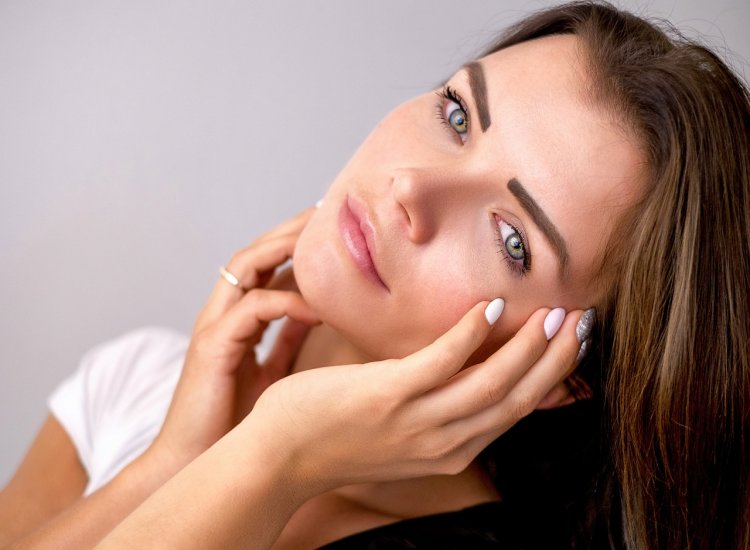

Retinol can be called a cornerstone in the realm of skincare. Many people cannot imagine a nightly skincare routine without it. What exactly is retinol? What are the facts and myths about it? How does it work? How to use retinol? We provide the answers below!
What exactly retinol is?
Retinol – a derivative of vitamin A – is definitely one of the most well-known skin care ingredients on the cosmetic market. It shares its skin-renewing benefits with topical retinoids (formulations containing synthetic compounds such as adapalene or tazarotene). Retinol undergoes conversion into retinoic acid once applied to the skin. Retinoic acid engages specific receptors within the skin cell and it enhances skin cell turnover acceleration.
Retinol is valued primarily for its precious properties. Retinol can stimulate collagen production as well as cell turnover and regeneration. It is often used to treat mature skin problems, as it may help to reduce wrinkles, fine lines, and hyperpigmentation. It may also help to improve and enhance skin texture. Furthermore, it’s worth using retinol as it also may help unclog pores. Not only that, it may exhibit significant efficacy in the fighting against acne.
You can find retinol in various concentrations in over-the-counter (OTC) products. It’s worth emphasising that retinols and prescription retinoids (which are much more powerful) are not the same products. However, retinol can rightfully be considered the strongest OTC version available, if we compare it with OTC retinoids such as retinyl palmitate and retinaldehyde. Retinol can be found especially in anti-aging skincare products – cosmetics manufacturers make the most of it, as it may help improve skin tone and overall youthful appearance. Those with ageing skin should consider making retinol an important part of a skincare routine.
What are the facts and myths about retinol?
When trying to discover more about retinol, you may find many myths. Actually, facts and myths intertwine, especially in the virtual world. In this paragraph, we would like to unravel the truths and misconceptions surrounding retinol’s influence on the skin.
Facts about retinol
Facts about retinol include its proven efficacy in promoting skin renewal. Retinol is supported by scientific research for its positive influence on skin condition and health. This organic chemical compound helps neutralise free radical damage in the middle layer of the skin. It may help to treat acne (mild acne, to be more precise).
What’s more, if you use a retinol product, you may notice reduced signs of ageing. Some photodamage that your skin might have experienced from time out in the sun may also be reduced. Generally, the overall appearance of your skin may be improved due to the retinol usage.
Myths about retinol
The biggest myth concerning retinol is that it can only be used in the evening/at night. The truth is that retinol can be applied on the skin during the day, as long as it’s paired with the proper sun protection. The person using a product with retinol has to remember about starting with lower concentrations and gradually increasing – the skin needs time to acclimate. The key is to ensure optimal benefits for skin without unnecessary irritation.
The next myth is that retinol ALWAYS causes skin irritation. The fact is that retinol may sometimes cause it, especially when you first introduce it into your skincare routine. This applies particularly to sensitive skin owners, as that type of skin may be prone to side effects such as dryness, redness, and flakiness. However, you don’t need to have irritated skin – it’s a matter of starting with lower concentrations of retinol. The trick is to increase frequency gradually as the skin builds tolerance. It is also a good idea to combine retinol use with a hydrating moisturiser – such a solution may help alleviate dryness and mitigate potential discomfort at the beginning of retinol use.
How does retinol work?
Many products for mature skin remove dead skin cells, but retinol works differently. To be more precise, the small molecules which make up retinol go deep beneath the outer layer of skin – epidermis – to your dermis. When it’s there, it helps boost the collagen and elastin production and that creates an effect of “plumping”, so wrinkles and enlarged pores may seem less visible. Retinol may also make sun spots and other signs of sun damage fade.
Remember that retinol works best when used regularly. We recommend using retinol every three days for three weeks. After that time, it’s worth moving up to using it every other day, and then every day. It may take up to 12 weeks until you see significant improvements, but it’s worth giving retinol a chance.

What should your skincare routine with retinol look like?
How to use retinol in your skincare routine? It’s not that difficult. A nightly skin care routine with retinol should start with a delicate cleanser to remove impurities. It’s worth choosing a cleanser with salicylic acid known for its exfoliating properties – combining retinol with salicylic acid can offer a synergistic and holistic approach to skincare and to achieving smoother, cleaner, and rejuvenated skin.
The next thing to do is to make sure that the skin is 100% dry. Only then you can apply retinol, as doing this in the right order helps minimise potential irritating effects. If you use it on wet or damp skin, you may expect retinol to penetrate more deeply and quickly, potentially leading to increased dryness and sensitivity.
That is why we recommend applying retinol serum, retinol cream or retinol oil to completely dry skin, followed by the application of a moisturiser to keep the skin hydrated. It is best to wait a few minutes before applying a moisturiser. When it comes to retinol products worth recommending, Nanili Professional® products deserve special attention, as they contain a complex of moisturising and soothing ingredients. They can help in the fight against acne, rosacea, increased sensitivity, lack of elasticity, or dryness.
What else can you do for your skin except using retinol products daily?
“Getting to know” retinol and “making friends” with it is a good start. Including it in everyday skincare routine is even better. But can you do anything more to your skin that is connected to using retinol? It turns out that yes, you can! You can take advantage of treatments specially prepared for your skin in a beauty salon.
Eva’s Beauty Room is a place offering skin diagnostics, acne treatments, cavitation peelings, ultrasounds, and many more beauty treatments. You can find Eva’s Beauty Room in Unit 2, Town Park Centre, TOWN PARK HOUSE, Tuam Rd, Galway, H91 YXN0. More information about the treatments can be found on this website: https://www.evabeautyroom.com/. Call Eva’s Beauty Room on: 085-1469036!
Summary
The article is a guide, providing insights into incorporating retinol into skincare routines and harnessing its potential for achieving a revitalised and youthful complexion. We hope more people will notice what retinol has to offer and how beneficial for skin it can be: it can help treat acne, regulate skin cell turnover, improve the appearance of both skin texture and skin tone. This is a really effective derivative of vitamin A!
This article was written in cooperation with Eva’s Beauty Room.


